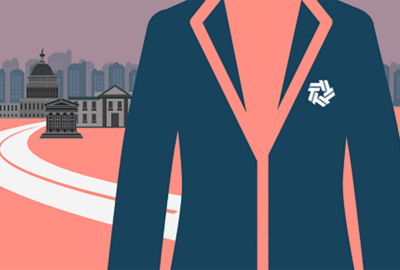Time for government, industry to meet in person again
Online events are here to stay, and with good reason. But some occasions demand in-person, and it's time already.
Happy days may not quite be here again quite yet. But people are plainly feeling more confident about getting the heck out of their dining room offices. What a contrast. Just as cold weather sets in for much of the nation, a springlike thaw occurs in the capacity of people to meet in person.

Wednesday night I emceed the annual awards ceremony of AFFIRM, the Association For Federal Information Resources Management. The long-running nonprofit brings the federal IT industry together with federal IT practitioners. Its goal is to foster improvement in how the government manages information technology — an activity with a yearly tab of $100 billion. Actually more, with the addition of Technology Modernization Fund and American Rescue Plan money designated for modernizing the government’s IT.
AFFIRM wasn’t the first to have an in-person confab. But it was one of the earliest I’m aware of to have one in D.C. Earlier this fall, the American Council for Technology-Industry Advisory Council (ACT-IAC) returned its annual conference to in-person up in Hershey, Pennsylvania.
I’d guess about 250 people attended the downtown D.C. event. What a feeling of return to drive up to a hotel turnout and hand the keys to a valet. Industry event sponsors all had people there. And the federal awardees attended, all but one or two of them.
Two awards went to people whose work directly enabled the government to keep going when the pandemic broke out.
Contracting officers Bobby McCane and Lester Ingol at FEMA were cited for quickly setting up contracts for $10 billion worth of personal protective equipment supplied by small businesses. Beth Capello, the deputy chief information officer at the Department of Homeland Security, was honoroed for getting technology in place to support 70,000 remote employees in a secure way.
Yet the AFFIRM event underscored just how reliably the grunt work of the federal government continued when people could not be together. Example: Karen Pica, from the Office of Federal Procurement Policy, oversaw a new iteration of a piece of a crucial, if arcane, portal known as the System for Award Management. SAM had been called beta for years. With the General Services Administration doing the technical work, SAM dropped the beta following a major upgrade just this past May.
These initial in-person events have the feeling of a homecoming. Lots of hugs, lots of handshaking. People checking to see who has gained weight, who has slimmed down. One of my favorite people, Onelia Codrington, the princpal of Performance Value Management, chided me in the hallway before the ceremonies to put my now-shoulder length hair into a pony tail. “Yes, if you’re going to be on stage!” she said. I did.
Which brings me to the revival of the Presidential Rank Awards program. This off-again, on-again program is on, again. Making up for last year’s cancellation, the Biden adminsitration just picked a small mob of recipients — 230 to be exact.
In earlier years, rank awardees were feted at dinners and awards ceremonies. To be sure, the Presidential Rank Awards come with a good chunk of dough. Awards from groups like AFFIRM come with a tchotchke, albeit a nice glass one. Money or not, though, awardees get a rush when named in-person and get a chance to walk across the dais, in the spotlights.
Plus, there’s real value in the talking and networking these events spark. Butting in at a couple of stand-up hors d’oeuvre tables with my martini, I eavesdropped on several job-seeking, hiring and corporate teaming tete-a-tetes.
Industry and government have gotten pretty good at virtual events. In fact, some of the little snafus at the recent in-person deals I’ve been to show we’ve gotten a little rusty. The difference: Zoom hiccups tend to be awkward or creepy. In-person glitches can be fun. At one recent event out of town, I was to interview, from the stage, a speaker online, appearing on two big screens. Only the connection was balky, so I had to ad-lib before 600 people for two minutes. That’s an eternity if you haven’t done it. But we had some good laughs — which couldn’t have happened in an all-online format. There’s a reason TV yakk shows have in-studio audiences.
Not that they’re listening, but my advice to the White House is to go ahead with an evening gala for the rank award winners. Pick a group to exectute on it— say, the Senior Executives Association. An organizer can easily gin up sponsors to cover the plated peppercorn salmon-and-risotto.
Lots of groups like AFFIRM, AFCEA, and ACT-IAC have monthly meetings of all types. They’ve learned there is value in having them online. More people attend because travel to-and-from time is cut. Organizers can produce high quality video recordings to archive. Online saves lots of money on venues, food, parking, badges and the rest of it. Thanks to technology, it’s an efficient way to host presentations and interactive content. I’ve participated in a million of them. And if I don’t have a pony tail thingy nearby it’s okay.
But sometimes people have to meet in person. It’s possible to do so now safely. People want to do it. And it has valuable, if intangible, benefits. It’s also possible to stream the ceremonies online for those who wish to still avoid crowds in person.
Now, pass those little wrapped hot dogs.
Nearly Useless Factoid
By Alazar Moges
The reason that popcorn pops is that there is a small amount of water stored inside a circle
of soft starch. The starch is surrounded by the kernel’s hard outer surface. When the kernel heats, the water expands. Once the outer layer breaks down, the popcorn explodes. As it explodes, the soft starch inside the popcorn becomes inflated and bursts, turning the kernel inside out. The steam inside the kernel is released, and the popcorn is popped.
Source: USDA
Copyright © 2025 Federal News Network. All rights reserved. This website is not intended for users located within the European Economic Area.
Tom Temin is host of the Federal Drive and has been providing insight on federal technology and management issues for more than 30 years.
Follow @tteminWFED






